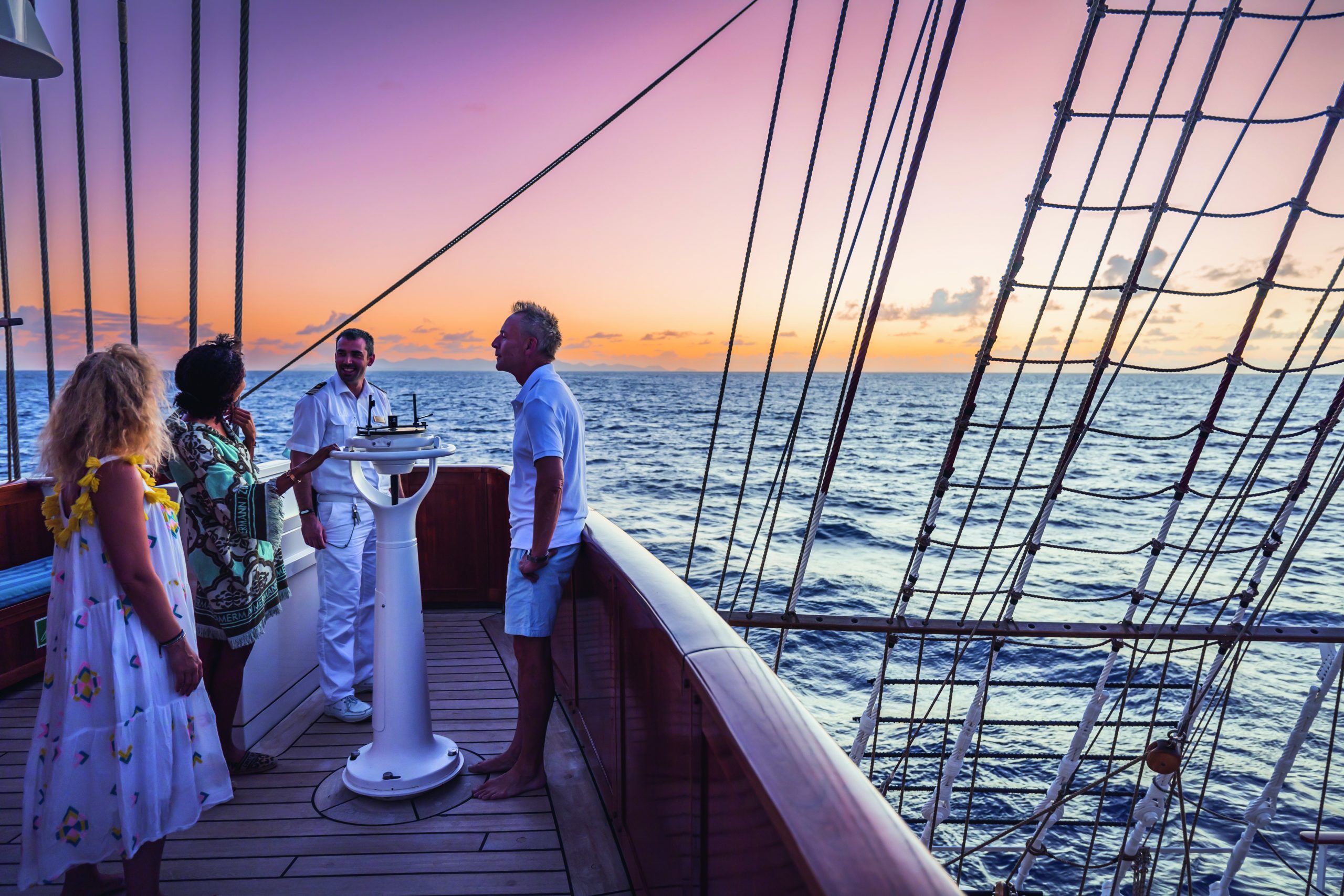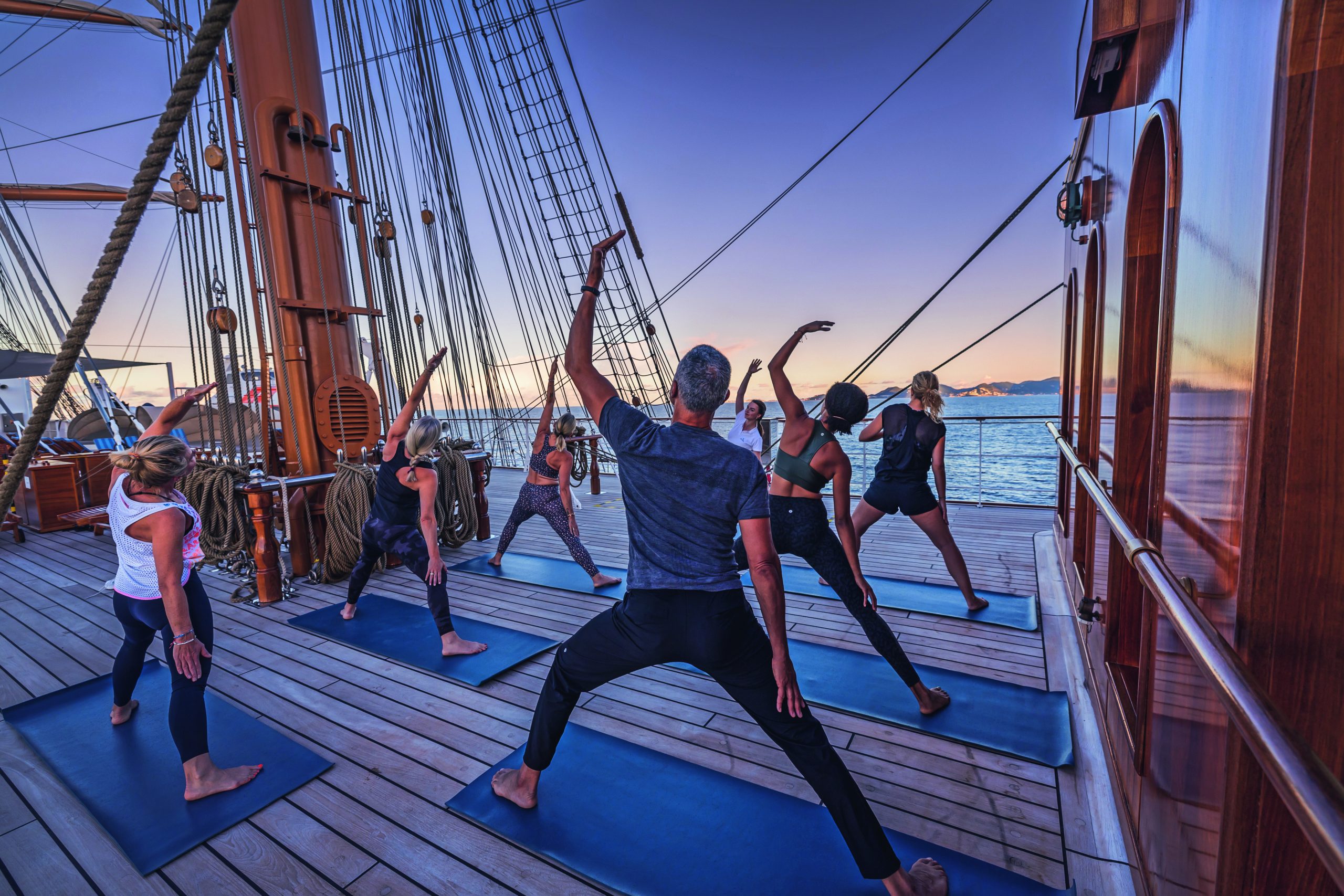Itinerary
Malta’s capital, the minicity of Valletta, has ornate palaces and museums protected by massive fortifications of honey-color limestone. Houses along the narrow streets have overhanging wooden balconies for people-watching from indoors. Generations ago they gave housebound women a window on the world of the street. The main entrance to town is through the City Gate (where all bus routes end), which leads onto Triq Repubblika (Republic Street), the spine of the grid-pattern city and the main shopping street. Triq Mercante (Merchant Street) parallels Repubblika to the east and is also good for strolling. From these two streets, cross streets descend toward the water; some are stepped. Valletta’s compactness makes it ideal to explore on foot. City Gate and the upper part of Valletta are experiencing vast redevelopment that includes a new Parliament Building and open-air performance venue. The complex, completed mid-2013, has numerous pedestrian detours in place along with building noise and dust. Before setting out along Republic Street, stop at the tourist information office on Merchant Street for maps and brochures.
Trapani, the most important town on Sicily’s west coast, lies below the headland of Mount Erice and offers stunning views of the Egadi Islands on a clear day. Trapani’s Old District occupies a scimitarshaped promontory between the open sea on the north and the salt marshes to the south. The ancient industry of extracting salt from the marshes has recently been revived, and it is documented in the Museo delle Saline. In addition to the salt marshes,Trapani’s other interesting environs include the beautiful little hill town of Erice, the promontory of Capo San Vito stretching north beyond the splendid headland of Monte Cofano, the lovely island of Motya and the town of Marsala. Trips farther afield will take you to the magnificent site of Segesta or the Egadi Islands, reached by boat or hydrofoil from Trapani Port.
Trapani, the most important town on Sicily’s west coast, lies below the headland of Mount Erice and offers stunning views of the Egadi Islands on a clear day. Trapani’s Old District occupies a scimitarshaped promontory between the open sea on the north and the salt marshes to the south. The ancient industry of extracting salt from the marshes has recently been revived, and it is documented in the Museo delle Saline. In addition to the salt marshes,Trapani’s other interesting environs include the beautiful little hill town of Erice, the promontory of Capo San Vito stretching north beyond the splendid headland of Monte Cofano, the lovely island of Motya and the town of Marsala. Trips farther afield will take you to the magnificent site of Segesta or the Egadi Islands, reached by boat or hydrofoil from Trapani Port.
Once the intellectual capital of southern Europe, Palermo has always been at the crossroads of civilization. Favorably situated on a crescent-shaped bay at the foot of Monte Pellegrino, it has attracted almost every culture touching the Mediterranean world. To Palermo’s credit, it has absorbed these diverse cultures into a unique personality that is at once Arab and Christian, Byzantine and Roman, Norman and Italian. The city’s heritage encompasses all of Sicily’s varied ages, but its distinctive aspect is its Arab-Norman identity, an improbable marriage that, mixed in with Byzantine and Jewish elements, created some resplendent works of art. No less noteworthy than the architecture is Palermo’s chaotic vitality, on display at some of Italy’s most vibrant outdoor markets, public squares, street bazaars, and food vendors, and above all in its grand climax of Italy’s most spectacular passeggiata (the leisurely social stroll along the principal thoroughfare).
The largest and most developed of the Aeolians, Lipari welcomes you with distinctive pastel-color houses. Fields of spiky agaves dot the northernmost tip of the island, Acquacalda, indented with pumice and obsidian quarries. In the west is San Calogero, where you can explore hot springs and mud baths. From the red-lava base of the island rises a plateau crowned with a 16th-century castle and a 17th-century cathedral.
The medieval cliff-hanging town of Taormina is overrun with tourists, yet its natural beauty is still hard to dispute. The view of the sea and Mt. Etna from its jagged cactus-covered cliffs is as close to perfection as a panorama can get—especially on clear days, when the snowcapped volcano’s white puffs of smoke rise against the blue sky. Writers have extolled Taormina’s beauty almost since it was founded in the 6th century BC by Greeks from nearby Naxos; Goethe and D. H. Lawrence were among its well-known enthusiasts. The town’s boutique-lined main streets get old pretty quickly, but the many hiking paths that wind through the beautiful hills surrounding Taormina promise a timeless alternative. A trip up to stunning Castelmola (whether on foot or by car) should also be on your itinerary.
Siracusa, known to English speakers as Syracuse, is a wonder to behold. One of the great ancient capitals of Western civilization, the city was founded in 734 BC by Greek colonists from Corinth and soon grew to rival, and even surpass, Athens in splendor and power. It became the largest, wealthiest city-state in the West and a bulwark of Greek civilization. Although Siracusa lived under tyranny, rulers such as Dionysius filled their courts with Greeks of the highest cultural stature—among them the playwrights Aeschylus and Euripides, and the philosopher Plato. The Athenians, who didn’t welcome Siracusa’s rise, set out to conquer Sicily, but the natives outsmarted them in what was one of the greatest military campaigns in ancient history (413 BC). The city continued to prosper until it was conquered two centuries later by the Romans.Present-day Siracusa still has some of the finest examples of Baroque art and architecture; dramatic Greek and Roman ruins; and a Duomo that’s the stuff of legend—a microcosm of the city’s entire history in one building. The modern city also has a wonderful, lively, Baroque old town worthy of extensive exploration, as well as pleasant piazzas, outdoor cafés and bars, and a wide assortment of excellent seafood. There are essentially two areas to explore in Siracusa: the Parco Archeologico (Archaeological Zone), on the mainland; and the island of Ortygia, the ancient city first inhabited by the Greeks, which juts out into the Ionian Sea and is connected to the mainland by two small bridges. Ortygia is becoming increasingly popular with tourists, and is starting to lose its old-fashioned charm in favor of modern boutiques.Siracusa’s old nucleus of Ortygia, a compact area, is a pleasure to amble around without getting unduly tired. In contrast, mainland Siracusa is a grid of wider avenues. At the northern end of Corso Gelone, above Viale Paolo Orsi, the orderly grid gives way to the ancient quarter of Neapolis, where the sprawling Parco Archeologico is accessible from Viale Teracati (an extension of Corso Gelone). East of Viale Teracati, about a 10-minute walk from the Parco Archeologico, the district of Tyche holds the archaeological museum and the church and catacombs of San Giovanni, both off Viale Teocrito (drive or take a taxi or city bus from Ortygia). Coming from the train station, it’s a 15-minute trudge to Ortygia along Via Francesco Crispi and Corso Umberto. If you’re not up for that, take one of the free electric buses leaving every 10 minutes from the bus station around the corner.
Malta’s capital, the minicity of Valletta, has ornate palaces and museums protected by massive fortifications of honey-color limestone. Houses along the narrow streets have overhanging wooden balconies for people-watching from indoors. Generations ago they gave housebound women a window on the world of the street. The main entrance to town is through the City Gate (where all bus routes end), which leads onto Triq Repubblika (Republic Street), the spine of the grid-pattern city and the main shopping street. Triq Mercante (Merchant Street) parallels Repubblika to the east and is also good for strolling. From these two streets, cross streets descend toward the water; some are stepped. Valletta’s compactness makes it ideal to explore on foot. City Gate and the upper part of Valletta are experiencing vast redevelopment that includes a new Parliament Building and open-air performance venue. The complex, completed mid-2013, has numerous pedestrian detours in place along with building noise and dust. Before setting out along Republic Street, stop at the tourist information office on Merchant Street for maps and brochures.
Ship features
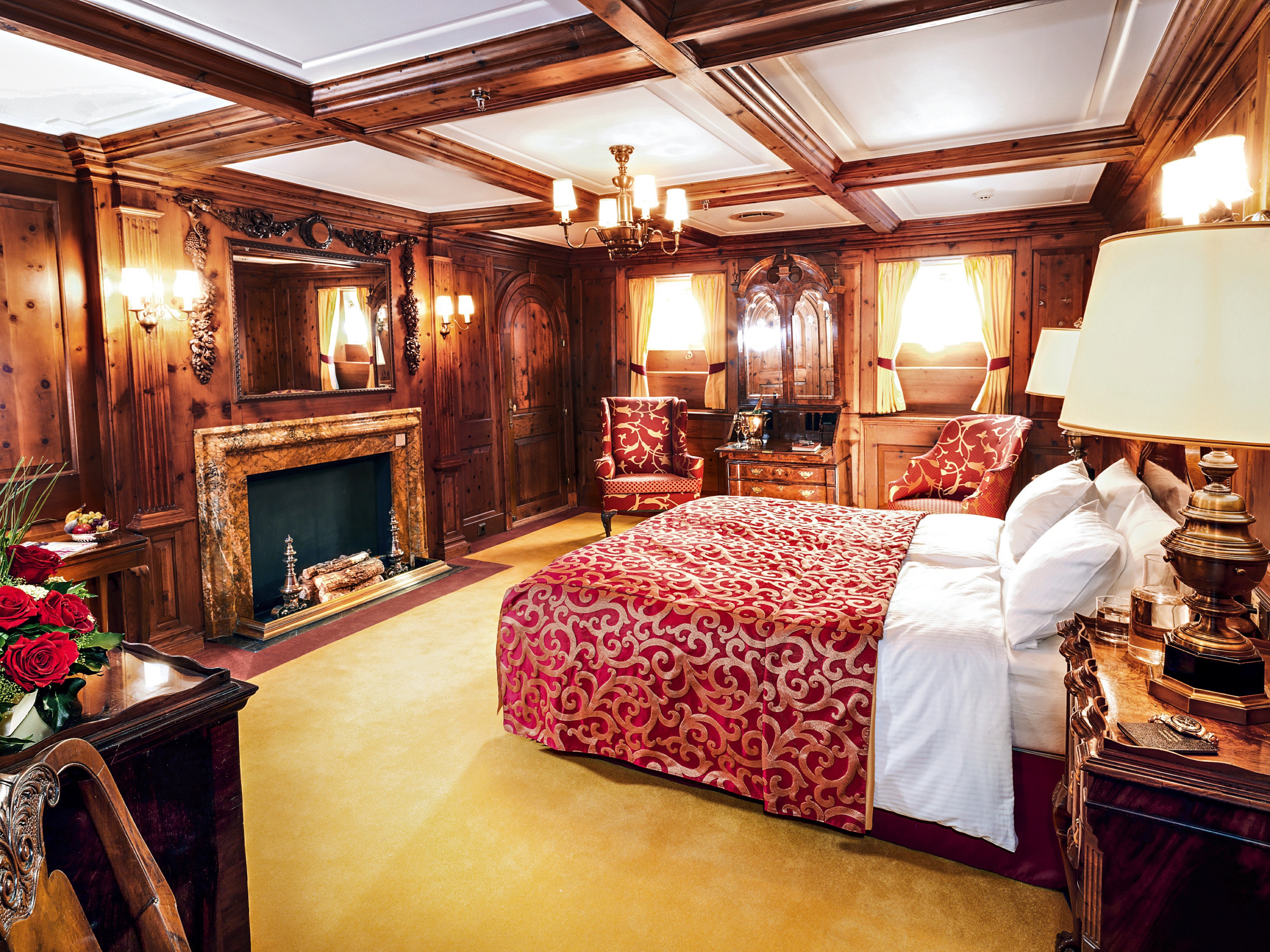
Luxury Owner's Cabin (Cat. A)
Like all the original accommodations, Marjorie Merriweather Post furnished the owner’s suites herself. Whenever she traveled aboard the SEA CLOUD, these posh, private quarters were her home, so she outfitted them in opulence. Today, her personal owners’ suite maintains her exquisite touch with white Carrara marble in the fireplace and bathroom, gold-plated swan fixtures, Louis Philippe chairs, an elaborate floor-to-ceiling dressing mirror and ornate golden-trimmed ceilings. The high-end design and furnishings reflect the successful entrepreneur’s penchant for luxuriating on this private yacht in ultimate comfort.
Cabin 1
- approx. 410 sq. ft. / 38 m2
- Marble bathroom approx. 97 sq. ft. / 9 m2 with shower and bathtub
- dressing table and golden fittings
- California king bed, 71 x 79 in. / 180 x 200 cm
- walk-in closet
- marble fireplace (electric)
- safe
Cabin 2
- approx. 366 sq. ft. / 34 m²
- marble bathroom approx. 97 sq. ft. / 9 m² with shower and bathtub
- California king bed, 71 x 79 in. / 180 cm x 200 cm
- walk-in closet
- marble fireplace (electric)
- safe
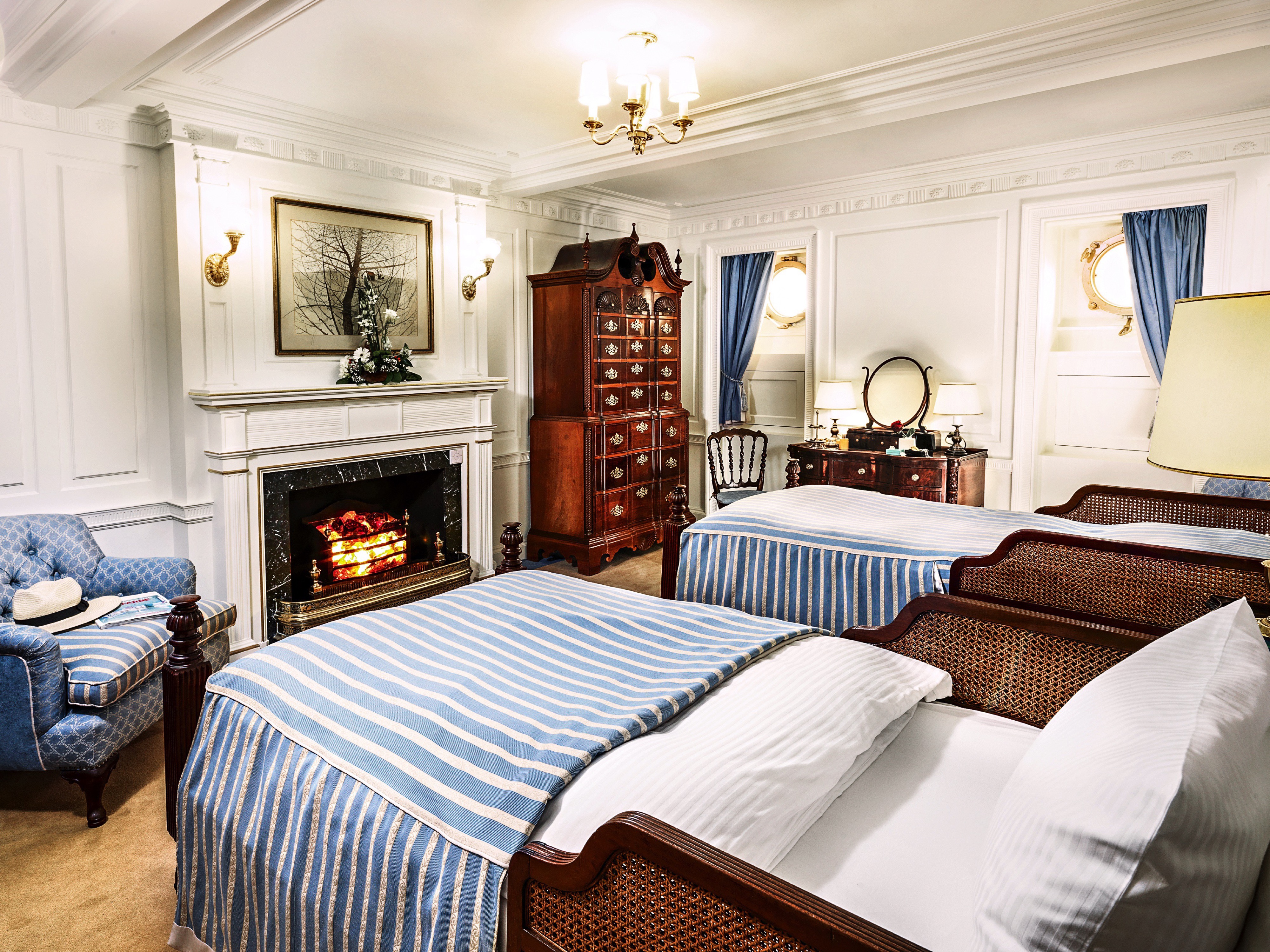
Deluxe Suite (Cat. B)
Suite 3 – The hospitality Marjorie cultivated still characterises a stay on board the SEA CLOUD today. The original colonial style of this deluxe suite continues to welcome guests with the posh comforts and ambiance of a private yacht. Renowned nobility, celebrities and industry titans have all called these deluxe suites home on legendary sailings.
- approx. 258 sq. ft. / 24 m²
- marble bathroom approx. 43 sq. ft. / 4 m² with shower, bathtub, and golden fixtures
- two twin beds, 36 in. x 79 in. / 90 cm x 200 cm each
- walk-in closet
- marble fireplace (electric)
- safe
Suite 4 – Throughout the commissioned construction of the SEA CLOUD in Kiel, Germany, and later when Marjorie was already living on board, she collected precious antiques from all over the world. This deluxe suite is one of the many examples of how skilfully she integrated the valuable pieces into the interior, and thus, into the overall appearance and ambiance of her private luxury yacht.
- approx. 237 sq. ft. / 22 m²
- marble bathroom approx. 54 sq. ft. / 5 m² with shower, bathtub, and golden fixtures
- queen bed, 63 in. x 79 in. / 160 cm x 200 cm each
- walk-in closet
- marble fireplace (electric)
- safe
Suite 5 – Marjorie frequently mentioned her goal of making family, friends and notable guests feel at home every minute on board the SEA CLOUD. Accordingly, she designed spaces like this deluxe suite to feel like the ultimate in comfort, five-star accommodations. Antique mahogany chests of drawers, marble in the bathroom and by the fireplace and unique pieces create cozy elegance.
- approx. 215 sq. ft. / 20 m²
- marble bathroom approx. 58 sq. ft. / 5,4 m² with shower, bathtub, and golden fixtures
- two twin beds arranged as a double, 36 in. x 79 in. / 90 cm x 200 cm each
- walk-in closet
- marble fireplace (electric)
- safe
Suite 6 – Exclusive getaways on the SEA CLOUD are also journeys through time. The original design and decor of the deluxe suites feel like a portal to a bygone era of glamor. In the spirit of private yachting, this antique mahogany furniture was selected so as not to overwhelm the space, and the fabric palettes complement the light ambiance of elevated comfort.
- approx. 194 sq. ft. / 18 m²
- marble bathroom approx. 43 sq. ft. / 4 m² with shower, bathtub, and golden fixtures
- California king bed, 71 x 79 in. / 180 cm x 200 cm
- walk-in closet
- marble fireplace (electric)
- safe
Suite 7 – As the SEA CLOUD’s original owner, Marjorie designed the interiors of her luxury sailing yacht with such attention to detail because she wanted to offer her daughter, Dina Merrill, a wonderful and safe home on board. This is especially noticeable in this deluxe suite where Dina spent a large part of her childhood. The warm maple finishings stand out with dramatic mahogany inlays. The unusual floor plan, including an angled fireplace makes the space feel even larger.
- approx. 258 sq. ft. / 24 m²
- marble bathroom approx. 75 sq. ft. / 7 m² with shower, bathtub and golden fixtures
- two twin beds, 36 in. x 79 in. / 90 cm x 200 cm each
- walk-in closet
- marble fireplace (electric)
- safe
Suite 8 – The main deck, where the original suites are located, is the heart and soul of the SEA CLOUD. This deluxe suite envelopes guests in its spirit of an exclusive private yacht. It is on display in the all the details, from fixtures to furnishings to finishings, complemented with a regal red and coral palette. Built-in cabinetry creates extra space.
- approx. 268 sq. ft. / 25 m²
- marble bathroom approx. 65 sq. ft. / 6 m² with shower, bathtub, and golden fixtures
- California king bed (2 mattresses), 71 x 79 in. / 180 cm x 200 cm
- additional fold-out bed
- walk-in closet
- marble fireplace (electric)
- safe
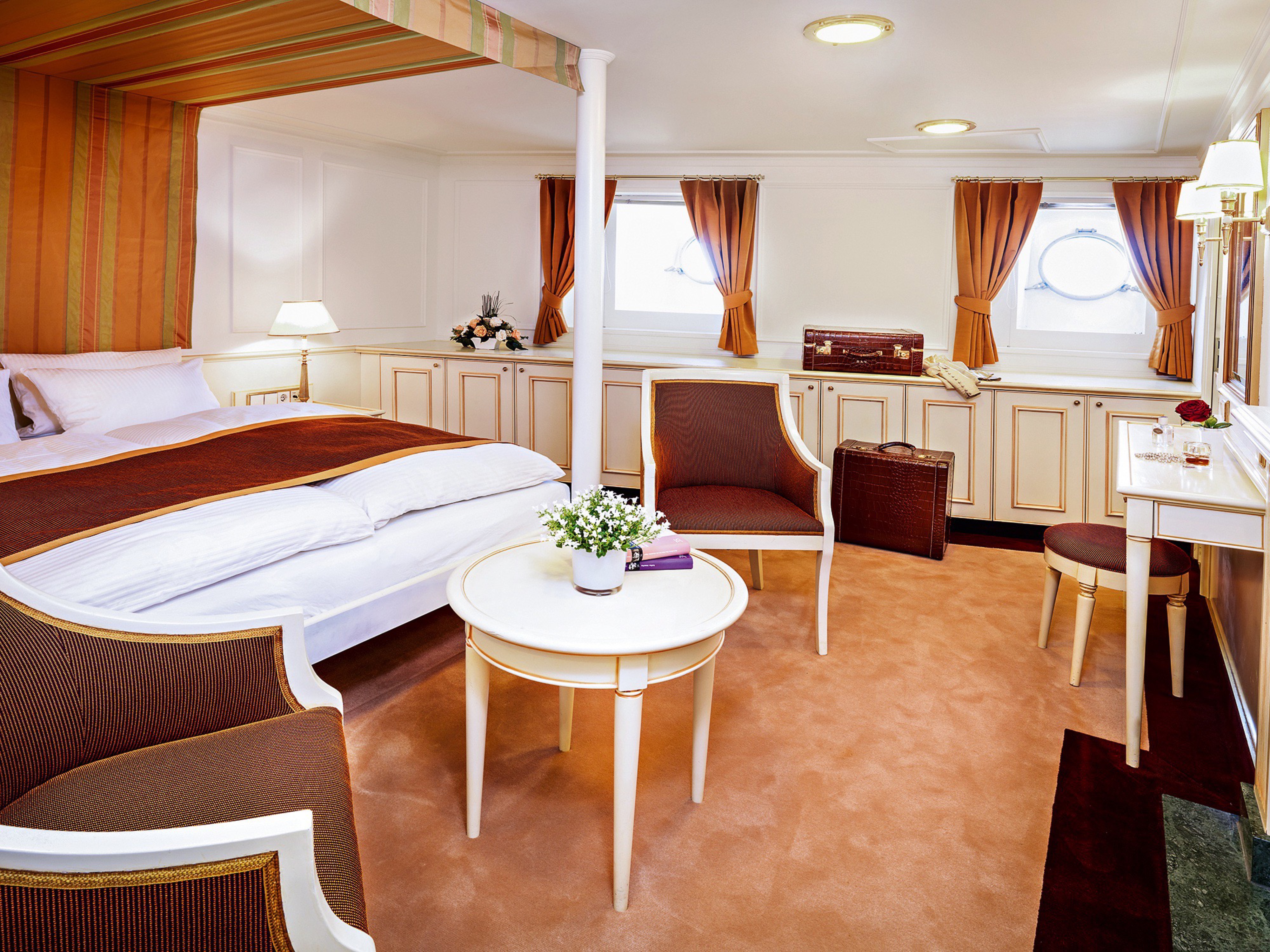
Deluxe Suite (Cat. C)
Deluxe Suites 9 and 10 are also part of the original accommodations on the main deck. Once used as single cabins for the former shipowners’ staff and their guests, they were redesigned into large luxury lodgings during renovation of the SEA CLOUD.
- approx. 215 sq. ft. / 20 m²
- marble bathroom approx. 35 sq. ft. / 3,6 m² with shower, bathtub, and golden fixtures
- queen bed, 63 in. x 79 in. / 160 cm x 200 cm
- walk-in closet
- generous storage space
- safe
The design of Deluxe Suites 9 and 10 is based on historical models with a modern aesthetic in warm fabrics and light wood tones. Both suites are located at the end of the original hallway and connect to the promenade deck by a separate staircase.
- approx. 198 sq. ft. / 18,5 m²
- marble bathroom approx. 39 sq. ft. / 3,3 m² with shower and golden fixtures
- queen bed, 63 in. x 79 in. / 160 cm x 200 cm
- walk-in closet
- generous storage space
- safe
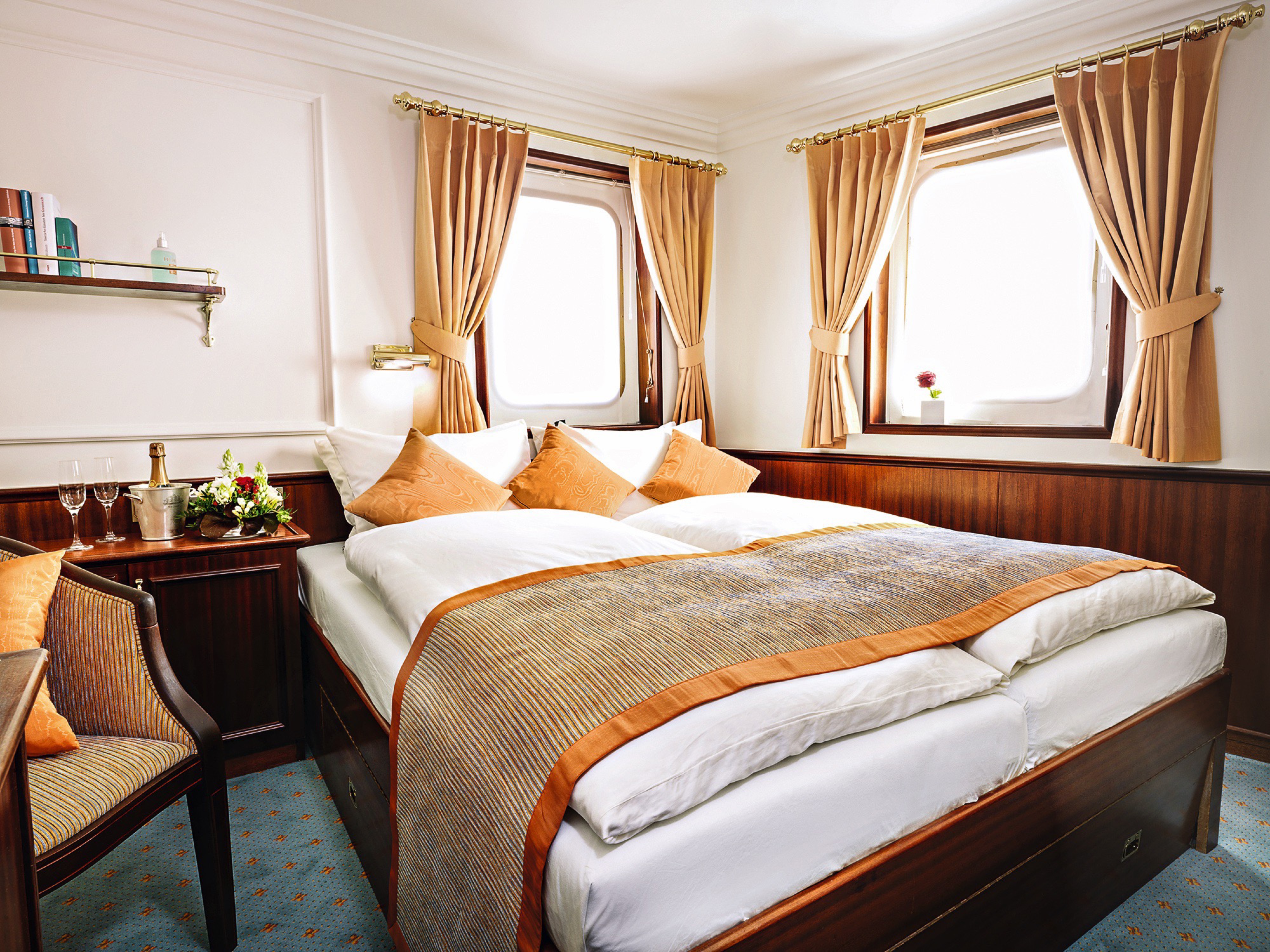
Cat. 1 Staterooms
Like all staterooms on the captain’s and lido deck, these two were built as recently as the late 1970s and offer all the comforts of private yacht accommodations. Panoramic windows cornering the head of the bed create a bright, airy vibe with views to match.
- approx. 140 sq. ft. / 13 m²
- marble bathroom with shower and golden fixtures
- queen bed (2 separate mattresses), 63 in. x 79 in. / 160 cm x 200 cm
- spacious closet
- safe
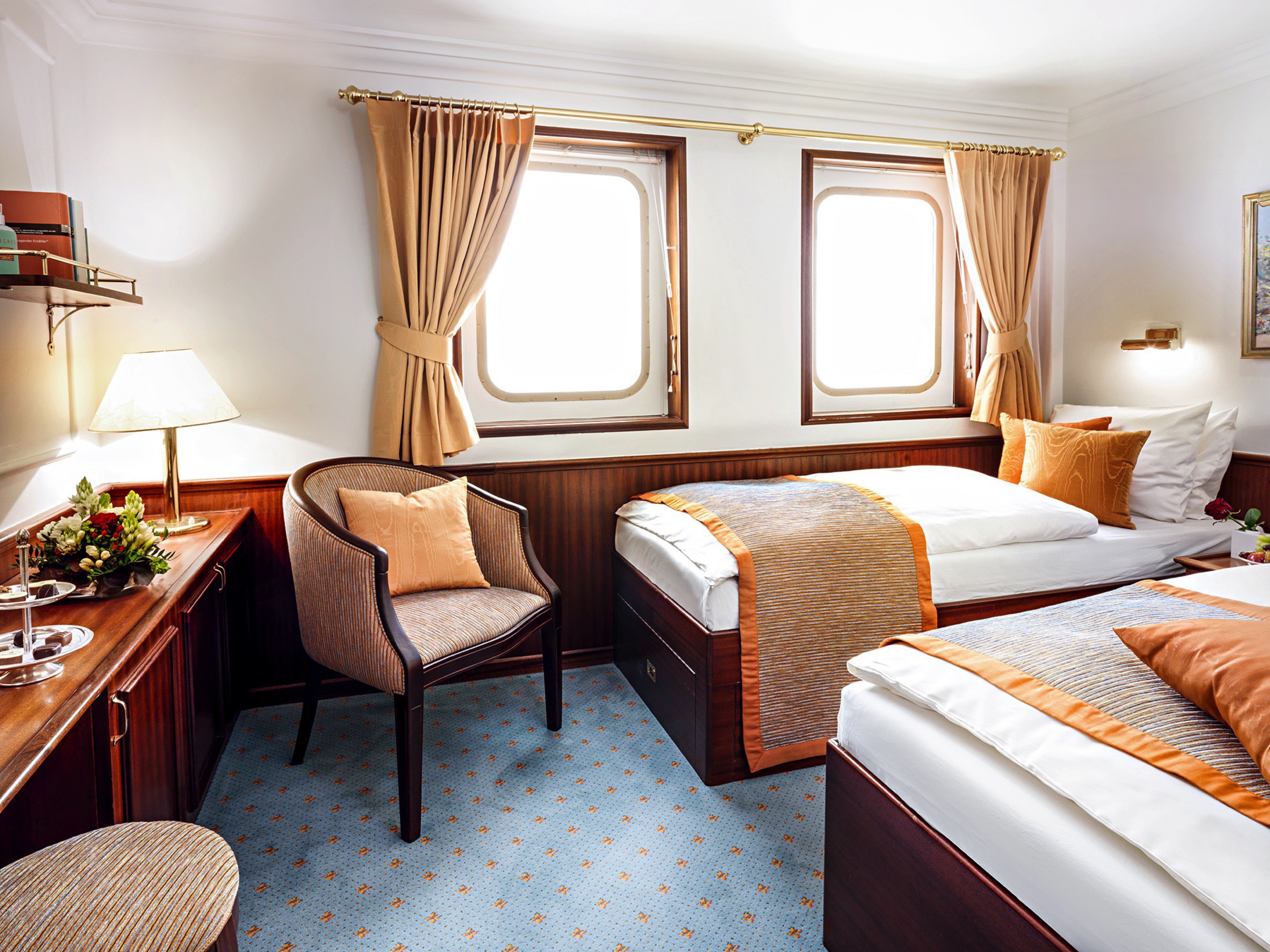
Cat. 2 Staterooms
Even though the staterooms on the captain’s and lido deck were harmoniously integrated into the SEA CLOUD after her initial construction, they still follow the design standards set on the original. Their tasteful interiors are a contemporary interpretation of Marjorie’s aesthetic from the 1930s. The elevated comfort of the spaces is complemented by spectacular sea views from double windows.
- approx. 145 sq. ft. / 13,5 m²
- marble bathroom with shower and golden fixtures
- two twin beds, 36 in. x 79 in. / 80 cm x 200 cm (convert to queen upon request)
- spacious closet
- safe
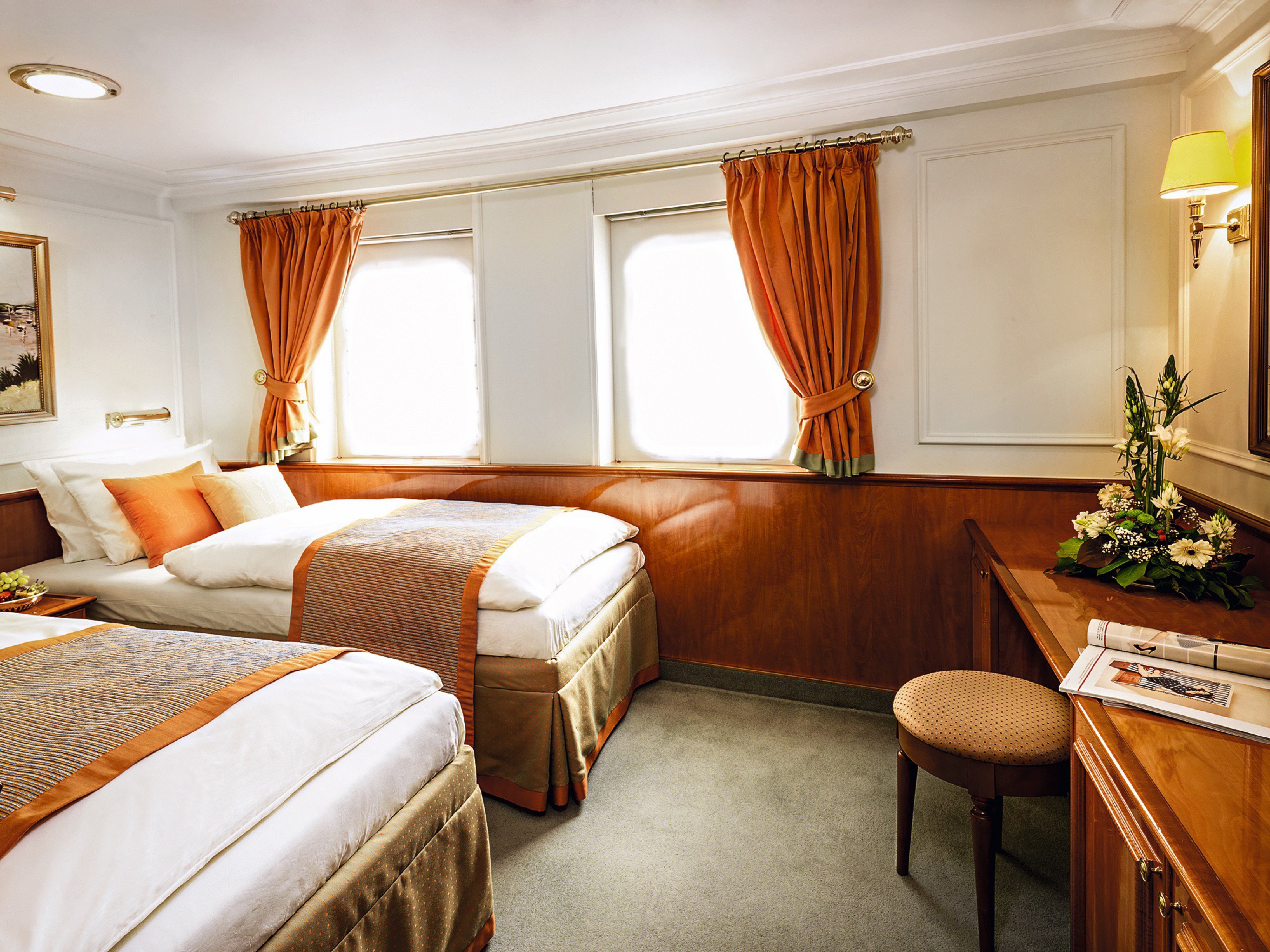
Cat. 3 Staterooms
These plush staterooms have a special maritime charm due to their location between the stations for hoisting and lowering the sails. The deckhouse, which was added during the renovation of the SEA CLOUD, is an oasis of peace, and due to its location on the promenade deck, the staterooms are also only steps away from the restaurant and lounge.
- approx. 135 sq. ft. / 12,5 m²
- marble bathroom with shower and golden fixtures
- two twin beds, 36 in. x 79 in. / 80 cm x 200 cm
- closet
- two windows with sea views
- safe
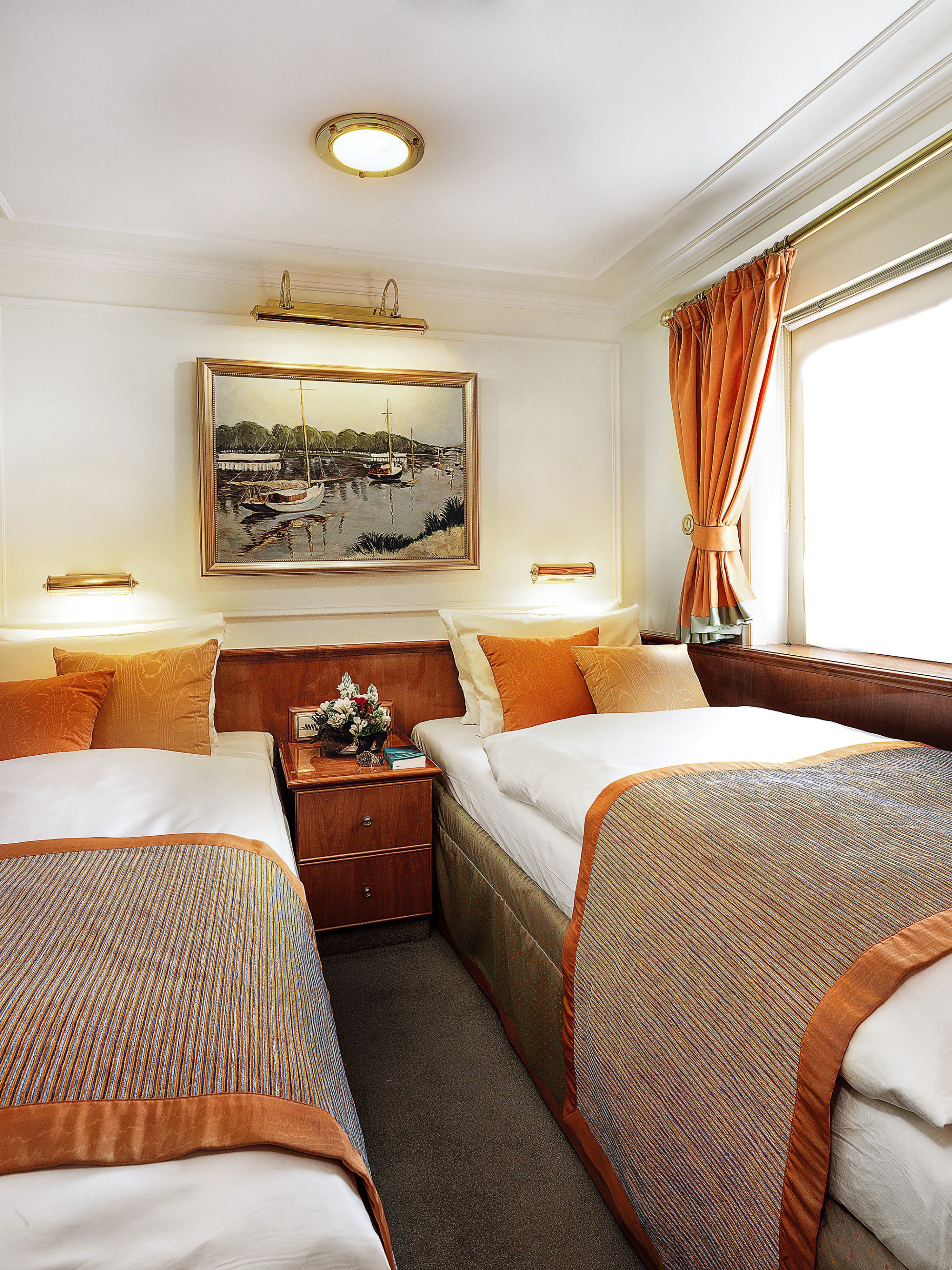
Cat. 4 Stateroom
In addition to the luxurious comfort that defines the SEA CLOUD, both staterooms offer a special feature: direct access to the most charming place on the tall ship, the Blue Lagoon. The semi-circular, blue-cushioned space is the traditional onboard area for relaxing under the daytime sun or dreamy night views of starry skies twinkling off the ocean.
- approx. 113 sq. ft. / 10,5 m²
- marble bathroom with shower and golden fixtures
- two twin beds, 36 in. x 79 in. / 80 cm x 200 cm
- closet
- window with sea view
- safe
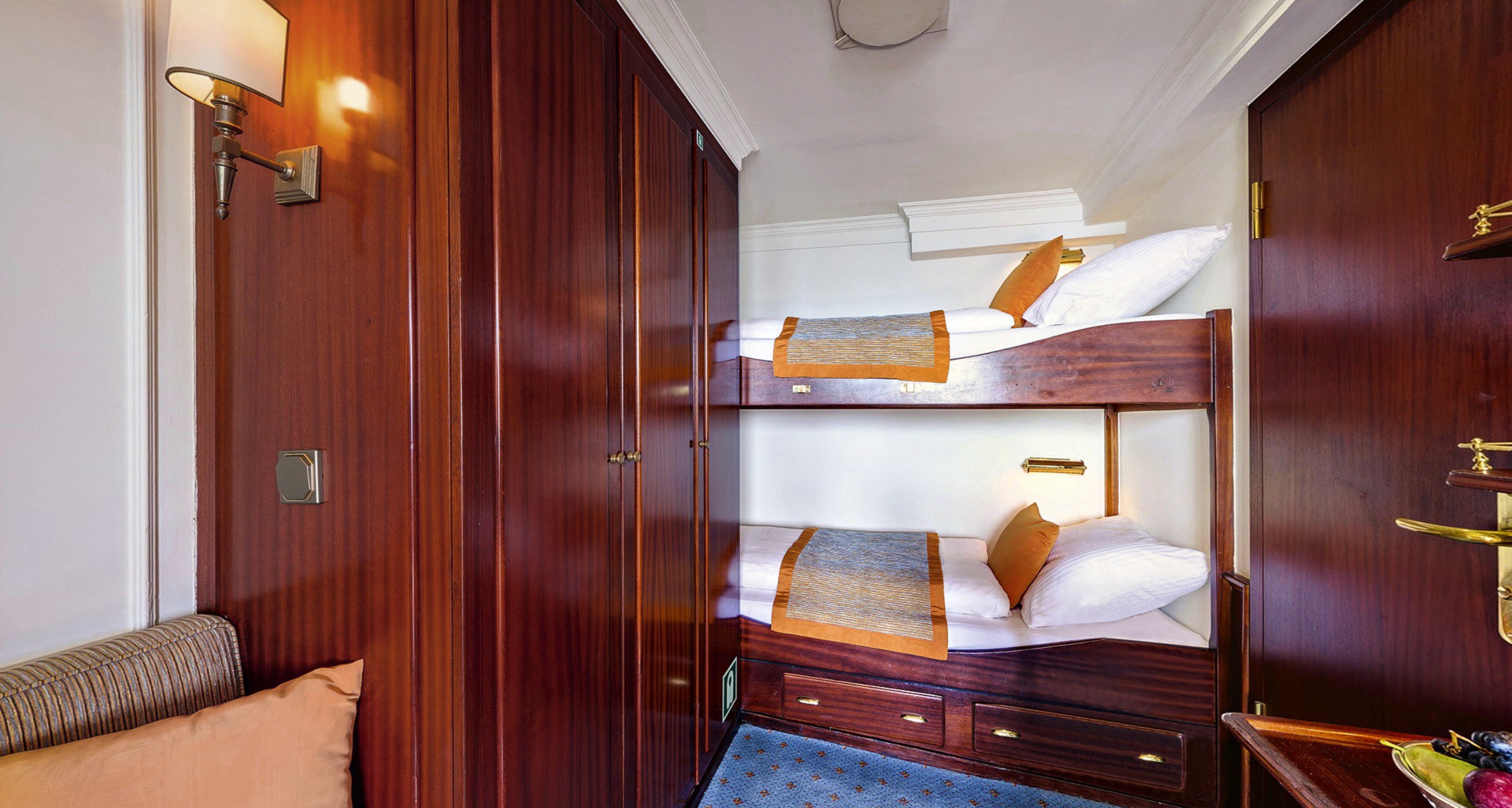
Cat. 5 Staterooms
These special staterooms were made for sailing enthusiasts. In Marjorie’s time, these were accommodations for SEA CLOUD officers, thus, the vibe is authentically nautical. The best part, which is exclusive to these staterooms, is direct access to the promenade deck, directly below the bridge. Open the door to breathe in the salty sea air and experience the charming maritime ambience.
- approx. 102 sq. ft. / 9,5 m²
- marble bathroom with shower and golden fixtures
- upper and lower beds, 32 in. x 79 in. / 80 cm x 200 cm
- closet
- porthole and door to promenade deck
- safe

Guarantee Cabins
Space is limited. Allocations are at SEA CLOUD CRUISES’ discretion starting in Category 5. You will receive your exact stateroom number when arriving on board.
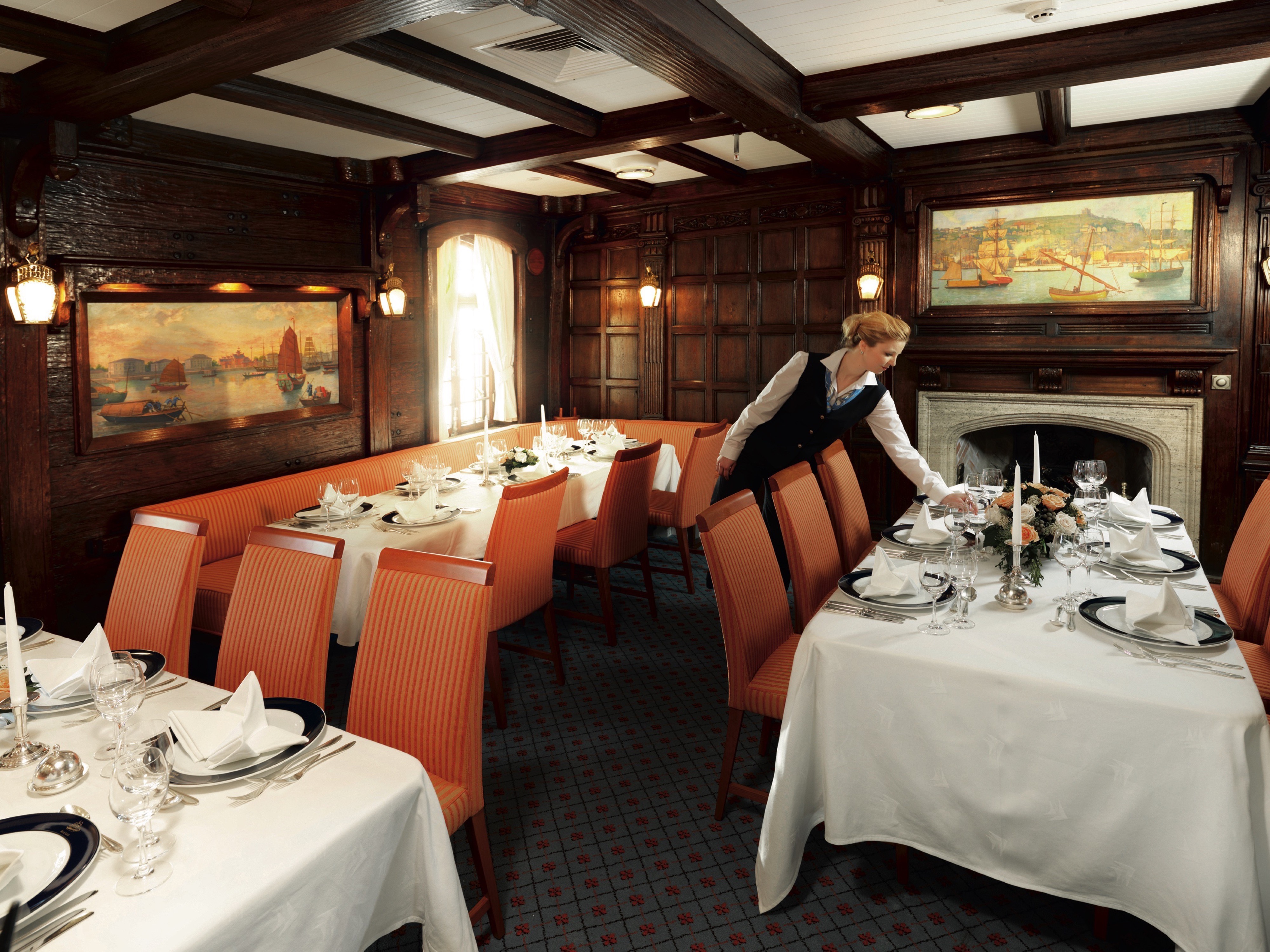
Dining On Board
Meals are served on our ships in one seating. Service times can be found in the daily program on board. Please kindly note that reservations are not possible.
A small breakfast with pastries and fruits is offered to early and late risers onboard the SEA CLOUDs. On the SEA CLOUD, it’s located on the Panorama Deck (early risers) or the Lido Deck (late risers). The main breakfast buffet is provided in the restaurant. Lunch is served as a buffet on the lido deck or in the restaurant. In the afternoon, coffee and tea are served, accompanied by some sweet treats and sandwiches. Dinner is a four-course menu with entrees to choose including a vegetarian option. Our executive chef will prepare an exclusive five-course meal for the gala dinner. A late-night snack nicely rounds up the evening’s culinary delights.
We maintain the tradition that at the beginning and towards the end of a voyage, the captain invites you to a Captain’s Cocktail, followed by a (Captain’s) Gala Dinner in the restaurant. For this occasion, we recommend elegant cocktail attire.
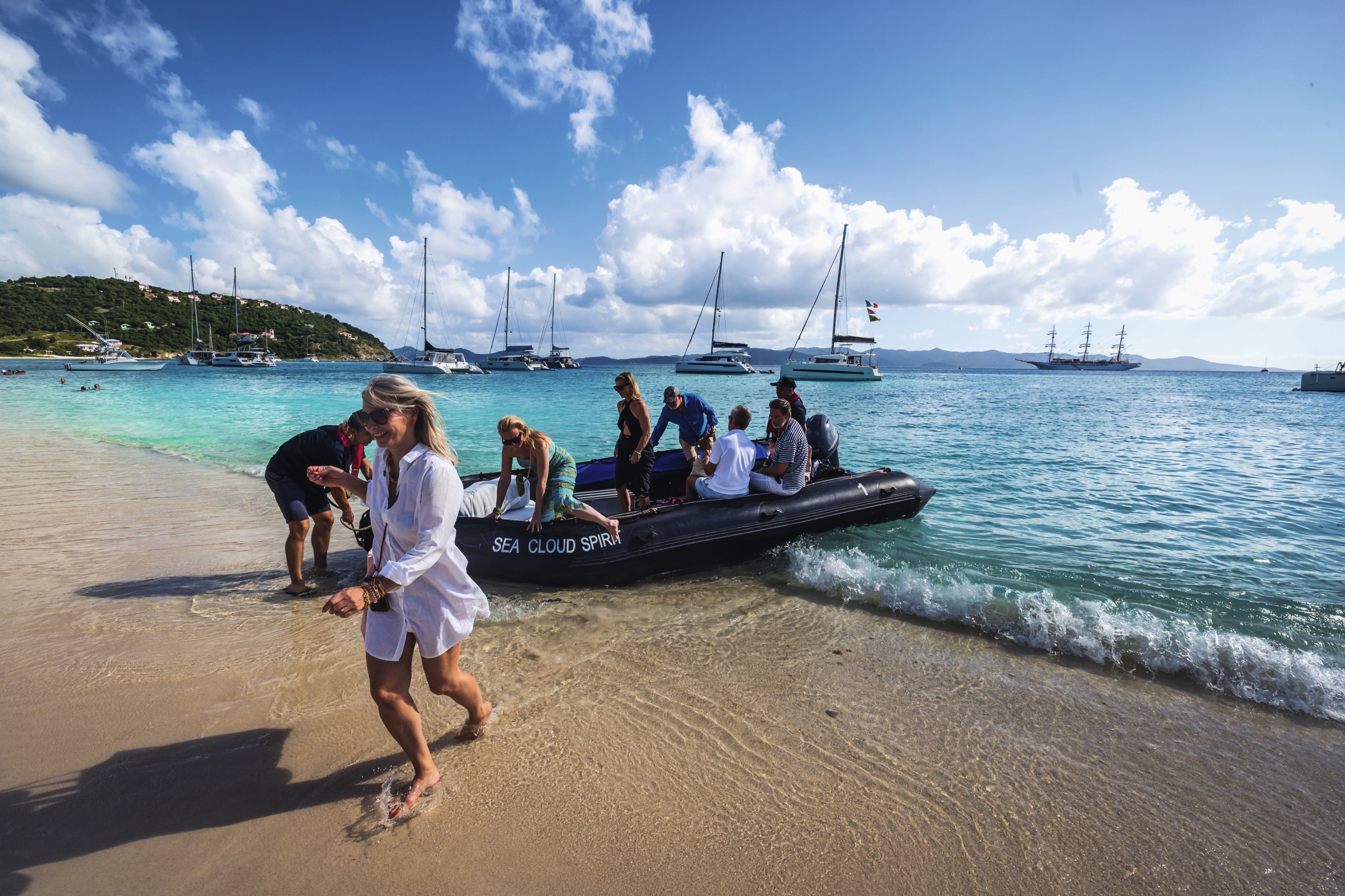
Zodiacs
Zodiacs are small motor-driven rigid-hull inflatable boats with a capacity of approximately 8 to 10 guests, primarily used for beach landings on our cruises or our photo safaris.

Watersports
Water sport activities are offered from the gangway on SEA CLOUD.
We do have snorkelling equipment in different sizes on board, stand-up paddle bards for beach landings.
All water sport activities are included and subject to weather and Captains permission.

Excursions
All our shore excursions are shown on the itinerary pages of our brochure. 4 weeks prior to departure you will receive detailed information on shore excursions with your travel documents. The shore excursion booklet also includes the order form to pre-book your excursions. On board the Cruise Director will be able to provide further details during a lecture. We do recommend pre-booking prior to embarkation to secure your spot. All excursions will be charged to your cabin account on board.
You are free to join an organised shore excursion, stay on board or make individual arrangements. You will find times for tender or to be back on board in your daily program and at the gangway.
Please remember to bring comfortable footwear, a light jacket/windbreaker, as well as sunscreen where appropriate.

Rigg Climbing
Join us for some rigg climbing
One of the most captivating experiences onboard the SEA CLOUD windjammer is watching the crew climb into the rigging to set the sails by hand. Now, you can share a piece of this adventure yourself and – if your fitness allows – climb up to the first platform!
Our SEA CLOUDs are the only cruise ships in the world that are traditionally sailed by hand. Here, nothing happens at the push of a button: setting the sails follows centuries-old rituals, bringing the magic of sailing to life in a unique way. Now, you can experience this tradition up close! High up in the rigging, carried by the wind and with sweeping views over the sea, you’ll feel the majestic power of our tall ships even more intensely. Safely guided and equipped with state-of-the-art safety systems, you can climb up to the first platform, about 14 meters above the deck – an unforgettable moment for those seeking adventure!
A brief fitness check on board ensures that you feel completely comfortable and secure before you ascend. This includes: hanging from a bar for 10 seconds, balancing on one foot for 20 seconds and climbing stairs two at a time. Our experienced deckhands, specially trained for these activities, will guide you every step of the way so you always feel safe and well taken care of.
Embark on this unique adventure now – a once-in-a-lifetime moment that will leave you with a deep sense of joy and a touch of pride. Are you ready to experience the sea in all its splendour, high above the sails?

The Lounge
The lounge is located on the Promenade Deck and is always open. This is where all lectures take place and on select sailings concerts on the Steinway grand piano (SEA CLOUD II and SEA CLOUD SPIRIT). Enjoy a selection of games or just an afternoon snack.
The Lounge Bar is open daily from 11:00 am. All drinks, alcoholic and non-alcoholic are included, premium drink are at an additional charge.
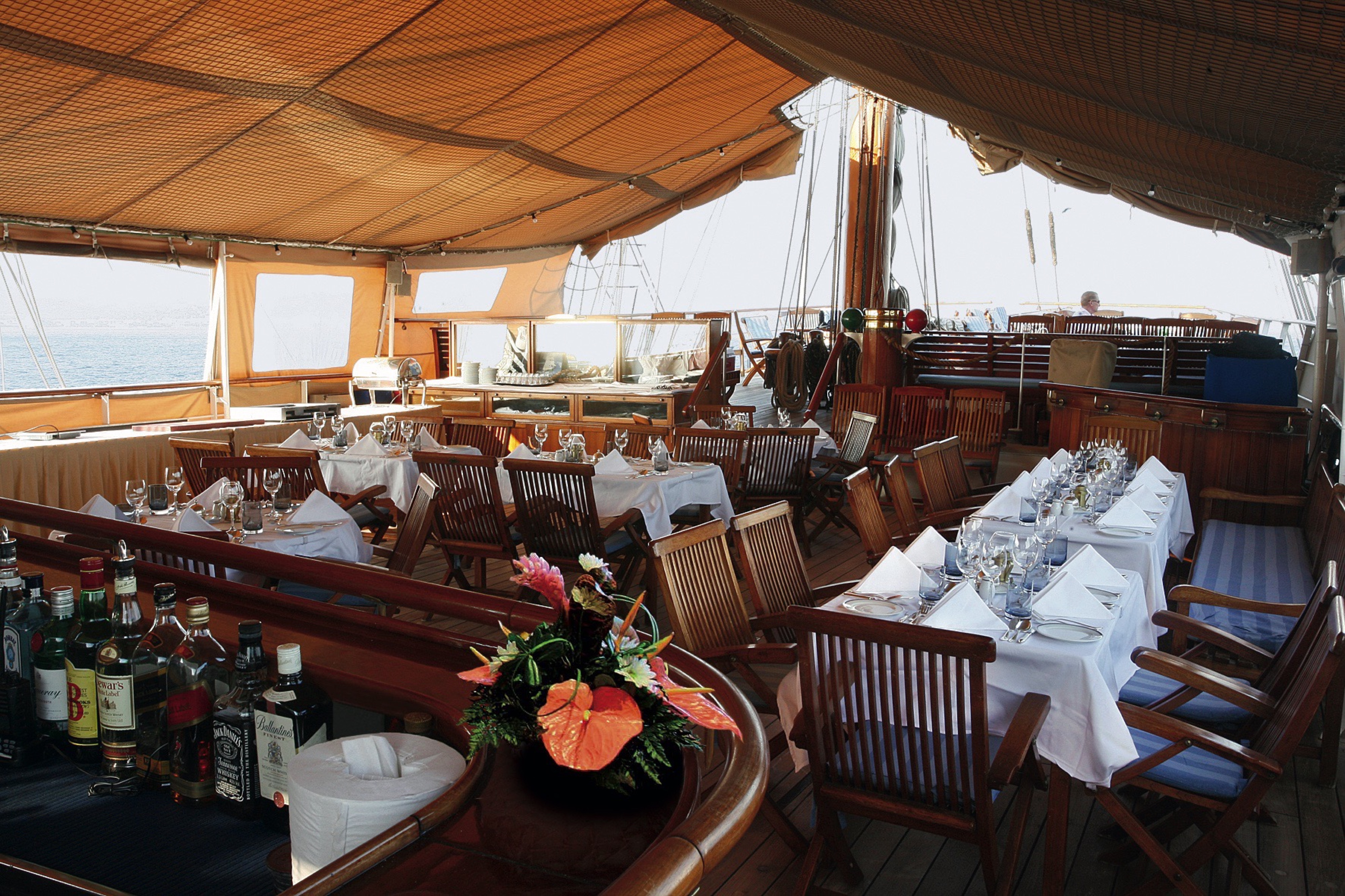
The Lido and Promenade Deck
If the weather is fine, you might like to sit on the lido deck at lunch time. The tasty snacks served at the buffet in the open air will both whet and satisfy your appetite. At certain times, our onboard pianist will provide pleasant background music to your conversations. The lido bar is a cosy place to wind down the evening. Quite befitting for any traditional sailing ship, the atmosphere can also get rather vibrant when the Crew Shanty Choir makes an appearance.
Not only is the promenade deck a quick route from one end of the ship to the other; in good weather, you will also find some very tasty refreshments there. The coffee, tea and light snacks are ideal for those who rise early, but also to provide sustenance in the afternoon between meals. Just imagine a freshly made waffle with ice cream under the white sails of a ship – that really is pure paradise!
The Lido is open daily from 11:00 am. All drinks, alcoholic and non-alcoholic are included, premium drink are at an additional charge.
Onboard SEA CLOUD, the ship’s office is located on the Promenade Deck and serves as a reception. The purser and radio operator are available from 8:00 am to 5:00 pm in the ship’s office.
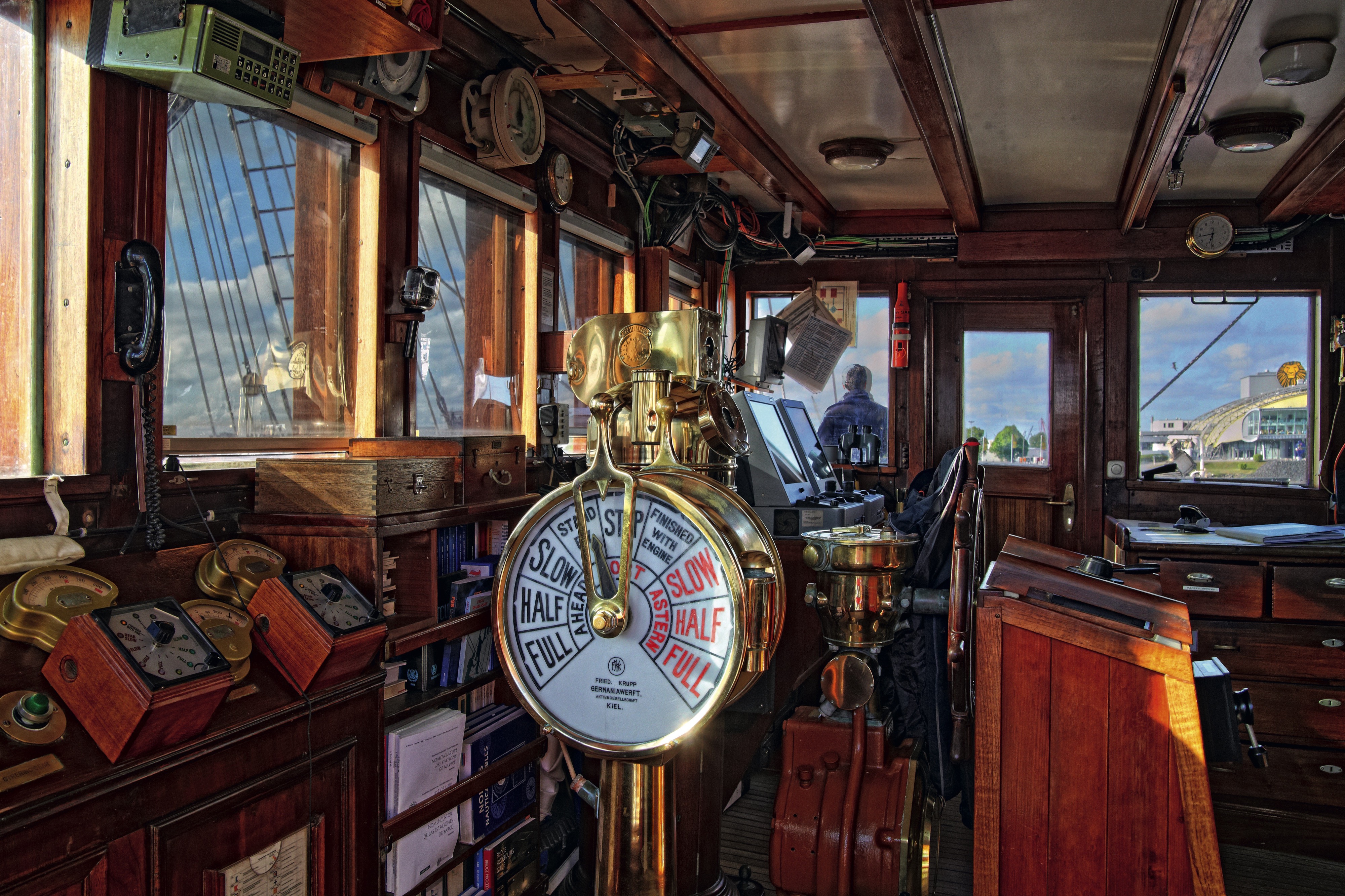
Bridge
The bridge area can be visited during the day and/or at specified times, subject to captain’s approval. The bridge is closed during manoeuvring operations and night sailing.

Boutique
The boutique on our yachts offers accessories, clothes, and gifts. The boutique’s opening times vary depending on the ship’s itinerary. You will find the exact hours in the daily program and on the displays. You can also contact the reception with questions or requests outside of opening hours.
Special Dietary Requirements
Please inform us prior to your cruise if you have any allergies, intolerances, or other special dietary restrictions. We will try to accommodate your needs as far as possible.
Dress Code
During the day, we recommend casual chic, yachting clothes. The evenings are casual elegant. Please refrain from wearing swimwear during lunch and/or shorts at dinner. For the Captain’s Dinner (once or twice depending on lengths of the cruise), we recommend elegant cocktail attire, a suit or ensemble for the gentleman and matching dress for the lady. We additionally suggest bringing non-slippery boat shoes.
Disabled Access
Our windjammers, SEA CLOUD, SEA CLOUD II and SEA CLOUD SPIRIT, are not barrier-free and, therefore, unsuitable for wheelchair users. Please contact our reservations directly for details.
There are no elevators on the SEA CLOUD and SEA CLOUD II, only staircases. SEA CLOUD SPIRIT is equipped with an elevator. You will access and depart the ship via the onboard gangway, which is not always level. Depending on weather conditions, access might be steep. The tenders or zodiacs service is done via the gangway. Please contact us prior to cruise if you have any questions regarding accessibility. If you need specific medical arrangements, please contact us in advance.
Smoking Policy
Smoking is permitted only on the lido deck outside of mealtimes. We kindly request that smokers take the other passengers into consideration. Smoking is always prohibited in covered areas on the lido deck, of the spanker deck (SEA CLOUD), on the blue lagoon (SEA CLOUD II), on the sun deck and on the verandah (SEA CLOUD SPIRIT).
Internet Access
Each of our yachts is equipped with Starlink satellite internet. All three ships offer WI-FI access in the public areas and in the staterooms. You can use your own laptop to access the Internet with an access code (WI-FI). Data volume of 10 GB is free of charge; additional data volume can be obtained from the reception desk at a charge. Continuous reception cannot be guaranteed; in certain sailing areas or due to the set course, interruptions to network coverage might be experienced. The WI-FI connection on a ship is not comparable to the usual reception on land.
On board, a laptop that is located in the lounge (SEA CLOUD) or in the library (SEA CLOUD II & SEA CLOUD SPIRIT) can be used for e-mail use on board. The SEA CLOUDs have their own on-board email addresses as follows:
SEA CLOUD: seacloud@seacloud.com
SEA CLOUD II: seacloud2@seacloud.com
SEA CLOUD SPIRIT: passenger@scs.seacloud.com
Please advise anyone you give the above email address to not send messages with attachments. Please put your name and cabin number in the subject line to ensure that the reception can forward any correspondence to you. They will hand you a printout of the e-mail.
Incoming and outgoing e-mails up to 50 KB in size can be received or send free of charge. However, files larger than 50 KB per message are automatically rejected by the system.
Due to limited network availabilities at sea, cell phones use is limited. The SEA CLOUDs are equipped with Starlink that ensures WIFI connection. Phone numbers to reach the ship can be found in your travel documents and on board.
Laundry Services
Laundry services on board are limited to washing and ironing. There is no dry cleaning available. You will find a price list for the overnight laundry and ironing service in your closet. For guests who have booked a suite in category A-C (SEA CLOUD) or category A+B (SEA CLOUD II & SEA CLOUD SPIRIT) the laundry service complimentary. For safety reasons, passengers are not permitted to iron in their cabins.
Children on Board
Children are welcome on our ships, but please keep in mind there is no daycare or special entertainment for children on board our ships.
Sustainability & Low Impact Tourism
OUR CONTRIBUTION TO ECO-FRIENDLY TRAVEL
We approach the people and their cultures with respect in all the regions we visit, travelling mindfully through the local environment. By doing this, we can bring our guests closer – in the truest sense of the word – to these places, and what makes each one special.
THE WINDJAMMER EXPERIENCE
For you and us alike, the key attraction of our trips is the chance to sail on the open seas.
We therefore take every opportunity to set sail and be propelled by the sheer power of the wind. That is why the captain will sometimes change the route if the weather requires it. On board our SEA CLOUD tall ships, you’ll experience the elements, as many of the day-to-day activities take place outside.
HAVING AS LITTLE IMPACT AS POSSIBLE
When we do have to start the engines, we utilise low-sulphur marine diesel on all three of our windjammers.
For us, this is standard practice. Even the SEA CLOUD, our very first windjammer, was equipped with this technology right from the start. Our motto: to minimise our impact on the environment yet still make a profound and positive impression on those around us.
A SUSTAINABLE APPROACH TO LIFE ON-BOARD
Avoiding plastic, reducing water usage and protecting the environment.
These are the factors that guide us in the day to day operation of our ships and our ongoing development of eco-friendly alternatives. To cite just one example, our reusable drinks bottles are not only easy on the eye, but also easy on the environment.
QUALITY, NOT QUANTITY
Our ‘small but perfectly formed’ windjammers are able to visit smaller ports, away from the busy routes frequented by large cruise liners.
With a maximum of 64 to 136 passengers, we’re always welcomed in those locations thanks to our approach of visiting local communities rather than overwhelming them. Needless to say, our itineraries also include some classic destinations, though we usually visit these only when the mega-liners have moved on.
BOOSTING THE LOCAL ECONOMY
Procuring supplies locally, working with local, smaller-scale agencies and paying fair prices.
By taking this approach, we see ourselves as a partner for our local service providers, with whom we’ve built relationships based on trust over many years. After all, we want our voyages to benefit both our guests and the communities we visit around the world.
AUTHENTIC CUISINE
Our menus are always a true reflection of the regional cuisine.
This is because our chefs enjoy buying exotic spices, local specialities and freshly caught fish from local markets to bring you – even in a culinary sense – closer to the places we visit.
A MEMBER OF THE FUTOURIS NETWORK
Heading into the future with Futouris.
Preserving the natural and cultural heritage of our world and shaping the future of tourism in a sustainable way is what Futouris stands for. Members of the network are working globally to improve people’s living conditions, preserve biodiversity and protect the environment and climate.
Medical Facilities
All three ships have a clinic and a ship’s doctor. Medical consultation hours can be found in the daily program. In case of an emergency, the doctor can be reached at any time by calling 911.
What's Included
Complimentary with your sailing:
- Welcome champagne in suite/stateroom
- Daily fresh fruit basket in suite/stateroom
- All meals including nightly 4-course menu and a 5-course gala dinner
- Fine wines from renowned winemakers and beer for lunch and dinner
- All non-alcoholic coffee and tea specialties
- All soft drinks
- Welcome and farewell cocktail
- Bottled water on excursions
- Gratuities and port fees
- Curated moments
- Beach barbecues in select destinations
- Marina platform with use of water sports equipment such as snorkel gear, stand-up paddleboards, and towable tube (weather permitting)
- Laundry service in suites

Captain's and Lido Deck
- Bridge
- Lido Bar
- Lido Deck
- Spanker Deck
- Category 1 Cabins (Double Bed)
- Category 2 Cabins (Twin Bed convertible to Double Bed)

Promenade Deck
- Purser
- Hospital
- Restaurant
- Lounge
- Category 3 Cabins (Twin beds)
- Category 4 Cabins (Twin beds)
- Category 5 Cabins (Lower and Upper bed)

Main Deck
- Category A Suites (Owner’s Suite)
- Category B Suites (Deluxe Suite)
-
Category C Suites (Deluxe Suite)

